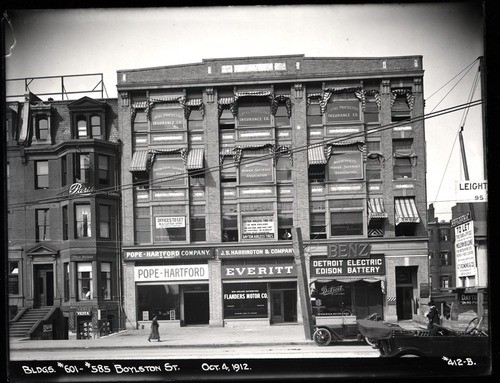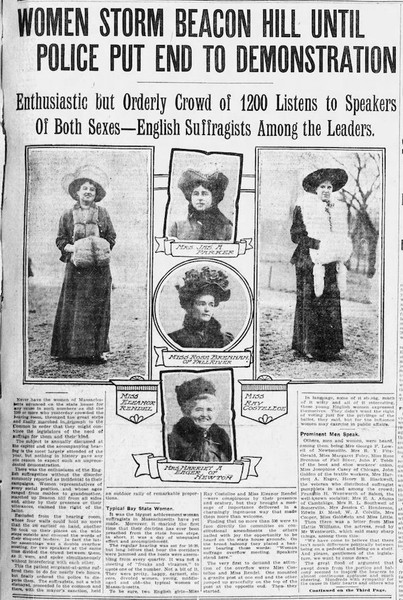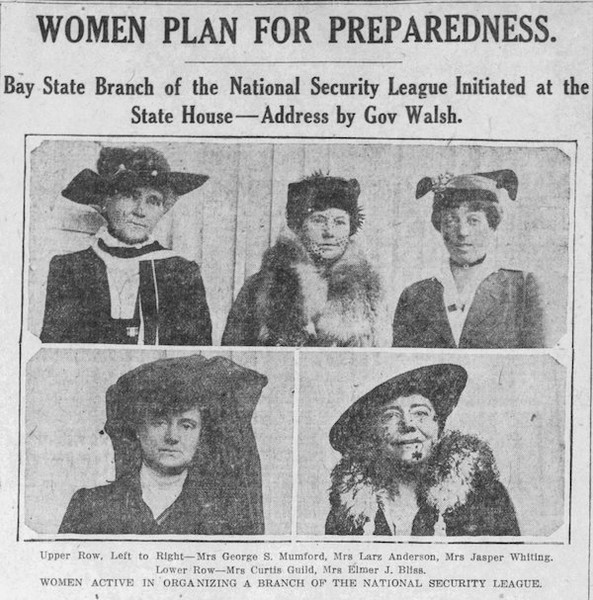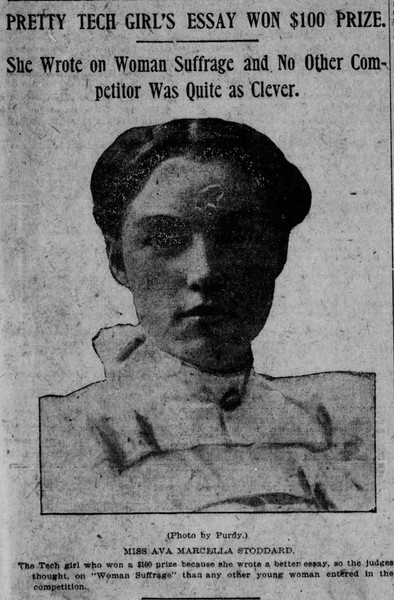Site of MWSA, BESAGG, the Woman's Journal and other Massachusetts Suffrage Groups 1909-1920
Introduction
Text-to-speech Audio
You are looking at a building which once housed many different women’s groups working towards women’s suffrage and other worthy causes.
585 Boylston was known as Chauncy Hall. In 1909 the New England Woman’s Club (NEWC) moved in.1 Clubs like this one provided information to women through lectures by prominent individuals, as well as providing ways for women to advance themselves through leadership roles. Interestingly, the club often shared space with the New England Woman Suffrage Association which was started by Julia Ward Howe (president of the NEWC), Lucy Stone amongst others at a conference in 1868.2 Although predominantly for women, men could join and many famous men such as Ralph Waldo Emerson and Henry James joined and/or gave lectures to the group.3 Many of the women who belonged to the club were also leaders in the suffrage movement.
Images
585 Boylston Street, 1912

Helen Schlesinger Parker – Mrs Jas (James) A. Parker. Top, middle photo. “Women Storm Beacon Hill Until Police Put a Stop to Demonstrations.” (February 24, 1909). Boston Globe.

Marion Schlesinger Whiting (Mrs Jasper Whiting), far right. “Women for Preparedness.”

Ava Stoddard, Pretty Tech Girl's Essay WON $100 prize

Backstory and Context
Text-to-speech Audio
The Massachusetts Woman Suffrage Association (MWSA), the Boston Equal Suffrage Association for Good Government (BESAGG), and the College Equal Suffrage League, all had their headquarters at Chauncy Hall, prompting Maud Wood Park to describe the building as a “Busy Hive Full of Workers for Women”4,5 (You can see the banners in the photo from 1912.) The Woman’s Journal (edited by Alice Stone Blackwell), a major suffragette publication, was housed here as well.5,6
At the many meetings that were held here, MIT alumnae were active participants, including such luminaries as Katherine Dexter McCormick (MIT 1904 S.B. Biology) and Florence Luscomb (MIT 1909 S.B. Architecture).7 Many women worked behind the scenes to support and advance the suffrage movement. Among the women whose names appear on the roll call of attendees were Helen Schlesinger Parker who attended MIT in 1896.8 She and her sister, Marion (attended 1903), both actively participated in supporting many social causes. This is not surprising since it was common for women of means to support worthy causes of all types
We are going to follow the lives of MIT attendees, Helen Schlesinger Parker and Marion Schlesinger Whiting:
Helen Schlesinger Parker became a medical practitioner after leaving MIT. (Women received medical training at various colleges and several were available in the northeast such as the Geneva Medical College, Boston Female Medical College, and the Medical School of Tufts College.) While we were unable to find where Helen did her training, her name appears on the rolls of those who passed the Massachusetts medical exam in 1903 (8). She had an active practice which she mentions during a talk she gave on the suffrage movement.9
As part of the suffrage movement, Helen was extremely active. She was an officer for both MWSA and CESL, spoke often at meetings, and attended parades (their version of protest rallies).10-13 Helen also supported abolition and attended and held fundraising benefits for children.14 Towards the end of WWI, some articles also list Helen as a supporter for war fundraising as well.15-16
Helen’s work also helped another MIT alum. Helen was an organizer in the creation of the Lucy Stone Fund that awarded scholarships through the College Equal Suffrage League (CESL). (The CESL was created to promote the suffrage movement on college campuses.)17 The winner of the CESL essay in favor of suffrage in 1901 was Ava M. Stoddard (MIT 1903 S.B. General Studies).18 Ava went on to become a journalist and later after her husband passed, ran the company Noone Sand and Gravel Company becoming one of the few prominent women business owners at the time.19-20
Marion Schlesinger (Burney) Whiting:
Helen had four siblings. Marion, her younger sister, attended MIT in 1903.21 In 1905 she married Jasper Whiting, the inventor of the Whiting process for the manufacture of cement and later the Whiting process for the manufacture of chlorine and caustic alkali from salt.22 He was listed as a lecturer at MIT and president of the Alumni Association 1914.23
Marion also supported, attended, and held fundraising benefits for children. For example, Marion was a supporter of the American Society for the Relief of French War Orphans and chaired the committee after the war ended.24-26 She also supported the Channing Home for poor women.27
When they passed, Marion and her husband created the Marion and Jasper Whiting Foundation. Every year the foundation solicits applications for a scholarship that provides money to teachers at colleges and universities so that they can study abroad and expand their knowledge and improve their material for teaching. The awards began immediately after Marion’s death and continue to this day.28
In summary, Helen and Marion were generous people who gave their time, energy, and resources to many worthy causes. Both women left a legacy of giving.
Sources
1. “Enters New Home”. (January 5, 1909). Boston Globe, p.10.
2. Sprague, J.A. (1894). History of the New England Woman’s Club from 1868 to 1893. Boston: Lee and Shepard Publishers.
3. Lois Bannister Merk, “Massachusetts and the Woman Suffrage Movement” (Phd diss., Radcliffe College, 1961).
4. Photo of Chauncy Hall Building; 585 Boylston jpeg (City of Boston Archives, 5000_009__0035, https://cityofboston.access.preservica.com/uncategorized/IO_065f8c48-aa8a-472f-b9a8-7e60a7c5f6ea/)
5. “Busy Hive Full of Workers for Women: Back Bay Building Alive with Organization for Equal Rights and Civic Betterment”. (February 23, 1913). Boston American.
6. Woman’s Journal, 28Oct1893 (co-editor) and Woman’s Journal, 28Oct1893 (editor)18Sept1909 (Alice Stone Blackwell is listed under header on top left: She was the daughter of two prominent people in the suffrage movement, Lucy Stone and H.B. Blackwell.)
7. “On Bedford Common.” (June 13, 1909). The Boston Globe.
8. Bever, M.A. (1976). The women of M.I.T., 1871 to 1941: Who they were, what they achieved. Thesis. [This thesis lists all the students who attended, what they studied, and what their degree was. p.29 Helen, p.35 Marion]
8. Registration in Medicine, Commonwealth of Massachusetts. 1903 Public Document – No 53. p.55. [This publication eventually became the New England Journal of Medicine.]
9. “Gives Tea for Suffragettes.” (May 8, 1913). Boston Globe. p.10
10. “Women Storm Beacon Hill Police Put an End to Demonstration. (February 24, 1909). Boston Globe.
11. “On Bedford Common.” (June 13, 1909). The Boston Globe Sun. (Helen listed as MWSA chair.)
12. “Mary Johnson to Speak”. (May 7, 1912). Boston Evening Transcript. (Helen is listed as the president of the CESL.)
13. “Tells of English Movement.” (May 8, 1913). Boston Evening Transcript. (Helen is listed as the president of the CESL.)
14. Massachusetts Society for the Prevention of Cruelty to Children, Annual Report. (1899/1900). George H. Ellis, Printer. (Helen’s name on p.178, 226, 280, & 341).
15. “Equal Suffrage Tea Dance for Soldiers”. (February 20, 1918). Boston Globe. (Helen is listed as a supporter.)
16. "Table Gossip." (May 5, 1918). Boston Globe Sun. (Helen is listed as a supporter of the Boston Equal Suffrage Association/Red Cross event.)
17. Marino, K. (2021). Students, Suffrage, and Political Change: The College Equal Suffrage League and Campus Campaigns for Women’s Right to Vote, 1905–1920. The Journal of the Gilded Age and Progressive Era, 20(3), 370-391.
18. Harper, H. (1922). History of Woman Suffrage. Volume 6, Chapter 20. https://en.m.wikisource.org/wiki/History_of_Woman_Suffrage/Volume_6/Chapter_20.
19. “Globe Extra! 6:30 O’clock ‘Play the game hard.’” (June 9, 1903). Boston Globe. (graduation listing her name)
20. Dominque, A. Biographical sketch of Ava Marcella Stoddard. Women and Social Movements, Part III: Mainstream Suffragists – National American Woman Suffrage Association. https://documents.alexanderstreet.com/d/1009638268
21. Bever, M.A. (1976). The women of M.I.T., 1871 to 1941: Who they were, what they achieved. Thesis. [This thesis lists all the students who attended, what they studied, and what their degree was. p.35]
22. Whiting-Global. The global center for research on the Whiting surname. https://tng.whiting-global.org/getperson.php?personID=I875&tree=USA. (Lists date of marriage and Jasper Whiting’s accomplishments.)
23. MIT Museum. Listing for Jasper Whiting. https://mitmuseum.mit.edu/collections/person/whiting-jasper-20375?query=jasper%20whiting&resultIndex=0
24. "Table Gossip." (April 22, 1917). The Boston Globe.
25. "Table Gossip." (February 3, 1918). The Boston Globe.
26. “Committee to End Work for Children of France.” (December 3, 1920). The Boston Globe.
27. “The Channing Home.” (March, 27, 1915). Boston Evening Transcript.
28. Whiting solicitation letter from 2021. https://www.hsph.harvard.edu/wp-content/uploads/sites/57/2020/11/2021-Whiting-Solicitation-Letter.pdf. If you google Marion and Jasper Whiting Foundation, you will find indications from colleges on the east coast advertising the scholarships.
1. 585 Boylston Street, 1912. City of Boston Archives, 5000_009__0035, https://cityofboston.access.preservica.com/uncategorized/IO_065f8c48-aa8a-472f-b9a8-7e60a7c5f6ea/
2. Helen Schlesinger Parker – Mrs Jas (James) A. Parker, (February 24, 1909). Boston Globe.
3. Marion Schlesinger Whiting (Mrs Jasper Whiting), far right, (October, 28, 1915). Boston Globe.
4. Ava Stoddard. Boston Post 28, May1901, p.7 https://www.newspapers.com/article/boston-post/812375/?locale=en-CA
